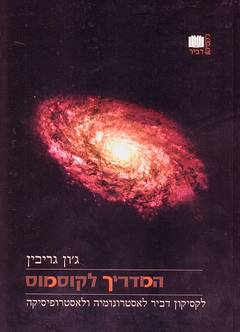John Gribbin - The Guide to the Cosmos - Dvir Lexicon of Astronomy and Astrophysics * Hebrew Emmanuel Lotem, scientific editor - Prof. Elia Leibovitz

The cosmos is the source of our existence and the effect of cosmic events on the earth is proven. Still, this is a field that is considered for professionals only. It was also difficult for enthusiasts to follow all the new developments without knowing where they came from.
Now you can make order in the mess. A good example of this can be obtained if you follow Olvers' paradox, which tries to understand why the sky is black and how this concept led to the understanding that the universe had a beginning in the big bang, since otherwise the lights of the most distant stars would reach us from every possible direction and would collectively illuminate the night sky.
As for the comment about our origins, as we know, every atom in the human body, except the hydrogen atoms, was created in nuclear processes that occurred inside stars, and spread through space in super nova explosions? We are all made of stardust - literally.
And one more thing - in the densest stars known to us, one cubic centimeter of matter weighs a hundred million tons. And more - in the book itself, which contains 608 easy-to-read pages even for those who are not particularly versed in astrophysics.
The Guide to the Cosmos - Dvir's Lexicon of Astronomy and Astrophysics, which was published in March 2002, allows anyone to familiarize themselves with astronomy
and in astrophysics using values for each concept. It actually contains everything - from scientific terms, through the life story and activities of scientists and other people who contributed to the development of the field, to spicy stories from the past.
The Hebrew edition of the book has a double name for a reason. In fact, these are serious additions compared to the seven-year-old English edition. First - there is reference to the work of Jewish and Israeli astronomers and physicists who contributed to the scientific world. The book also contains updates to various fields that were in their infancy when the book was written, such as the surprising discoveries of about fifty planets in other solar systems. The book is recommended.
Alex Doron, Maariv writes about the book:
Now also in Hebrew: a guide to the cosmos
For the first time in Hebrew - a lexicon for the terms of astronomy and astrophysics. "A Guide to the Cosmos" by John Gribbin (Hebrew: Emanuel Lotem; scientific editor: Prof. Elia Leibovitz, Tel Aviv University; Dvir Publishing), was published this week. It is based on the book by the astrophysicist Dr. Gribbin. Companion to the Cosmos
In the lexicon, over 1000 entries, some of them detailed and comprehensive. They present the various celestial bodies, new and old theories in the cosmological sciences, the tools used by astronomers and the prominent figures in the history of these sciences.
Prof. Leibovitz took the trouble to add some values that are of special interest to the Israeli reader. Also included in the book is a table of the 88 constellations and in each of them, the most prominent celestial bodies. The lexicon is equipped with a foreign-Hebrew key.
In the sea of information flowing from the pages of the book, one can learn, for example, that we are all made of the dust of stars - every atom in the human body, with the exception of the hydrogen atoms, was created as a result of nuclear reactions occurring within the stars, spreading through space in supernova explosions. And also: that the amount of dark matter is at least ten times greater than the amount of matter visible to the eye; And also that the most accurate clock known to man is the neutron star, the pulsar whose rotation period only changes by 75 millionths of a second every terrestrial year. Or in the most compact stars known today, 1 cm100 of material weighs XNUMX million tons.
